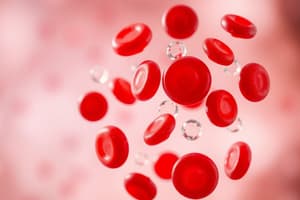Podcast
Questions and Answers
What is the primary role of endothelial cells in maintaining normal hemostasis?
What is the primary role of endothelial cells in maintaining normal hemostasis?
- Preventing thrombus formation (correct)
- Activating the coagulation cascade
- Releasing fibrin to form clots
- Aggregating platelets at injury sites
Which component is crucial for platelet adhesion during the hemostatic process?
Which component is crucial for platelet adhesion during the hemostatic process?
- Collagen fibrils (correct)
- Fibrinogen
- Serotonin
- Thrombin
What initiates the process of fibrinolysis?
What initiates the process of fibrinolysis?
- Platelet aggregation
- Plasminogen activator (correct)
- Thrombin release
- Calcium influx
What effect does thrombin have on platelets?
What effect does thrombin have on platelets?
Which of the following statements about alpha granules is true?
Which of the following statements about alpha granules is true?
What is the nature of the temporary plug formed by platelet aggregation?
What is the nature of the temporary plug formed by platelet aggregation?
What initiates the activation of the coagulation system during vascular injury?
What initiates the activation of the coagulation system during vascular injury?
Which substance is primarily contained in dense bodies of platelets?
Which substance is primarily contained in dense bodies of platelets?
What role does serotonin play in the hemostatic process?
What role does serotonin play in the hemostatic process?
What is the relationship between thrombosis and normal hemostasis?
What is the relationship between thrombosis and normal hemostasis?
Flashcards
What is an infarct?
What is an infarct?
The blockage of a blood vessel by a thrombus or embolus, leading to tissue death.
What is hemostasis?
What is hemostasis?
The process of forming blood clots to stop bleeding.
What is endothelium?
What is endothelium?
The inner lining of blood vessels, composed of endothelial cells.
What are platelets?
What are platelets?
Signup and view all the flashcards
What is fibrinolysis?
What is fibrinolysis?
Signup and view all the flashcards
What are platelet granules?
What are platelet granules?
Signup and view all the flashcards
What are alpha granules?
What are alpha granules?
Signup and view all the flashcards
What are dense bodies?
What are dense bodies?
Signup and view all the flashcards
What is platelet factor 3 (PF3)?
What is platelet factor 3 (PF3)?
Signup and view all the flashcards
What is thrombin?
What is thrombin?
Signup and view all the flashcards
Study Notes
Thrombosis and Hemostasis
- Thrombosis and embolism are closely related, with thrombosis resulting from inappropriate activation of normal hemostasis.
- Normal hemostasis depends on blood vessel components (wall, platelets, and clotting sequence).
- Blood vessel wall integrity is crucial.
- Endothelial cells:
- Release plasminogen activator for fibrinolysis.
- Inhibit platelet aggregation (e.g., ADP, prostaglandins).
- Subendothelial collagen fibers activate clotting factors and promote platelet adhesion.
- Platelets:
- Central role in hemostasis and thrombosis.
- Adhere to sites of injury (e.g., collagen), forming masses.
- Release granules:
- Alpha granules: fibrinogen, beta thromboglobulin, cationic protein, platelet factor 4 (a heparin neutralizing protein).
- Dense bodies: serotonin, ADP, ATP, and ionized calcium.
- Platelet activation triggering:
- Collagen fibers, thrombin, plasmin, trypsin, endotoxins, antigen-antibody complexes.
- Increased calcium concentration and platelet factor 3 activation, contributing to platelet aggregation.
- Platelets form temporary plug, initiate permanent plug (aggregated platelets and fibrin), release serotonin (vasoconstriction), and contribute to the coagulation cascade.
Studying That Suits You
Use AI to generate personalized quizzes and flashcards to suit your learning preferences.




